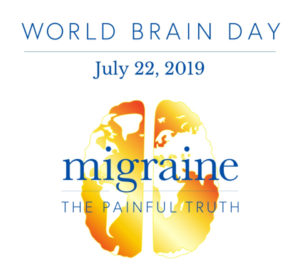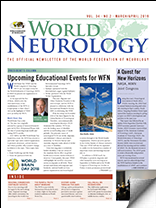A World Federation of Neurology and International Headache Society collaboration.
By Tissa Wijeratne, Wolfgang Grisold, David Dodick, Mohammad Wasay, and William Carroll
The Global Burden of Diseases Collaborators confirmed that neurological disorders are the leading cause of disability worldwide1. Globally in 2016, neurological disorders were the leading cause of disability-adjusted life years (276 million [uncertainty interval 247-308] and the second leading cause of deaths at 9.0 million [8.8-9.4]).

The world map printed on top of the hemispheres in the brain. The gold color denotes the World Federation of Neurology. The navy blue denotes the International Headache Society. The red denotes the pain.
Migraine is the most burdensome illness in people under the age of 50 (the group who contributes most to society through the workforce) and, in females2-4. Among people with migraine who experience more than 15 days per month with headache, 20 percent are occupationally disabled. Migraine with aura is associated with a 20 percent increased risk of mortality, and the suicide rate among people with cluster headache is 20 times the national average.
Lack of research support for and publications in the field of migraine from low-to-middle-income countries is disappointing and alarming5. The situation in high-income countries is still in tremendous need of progress. For example, in the United States, migraine and headache disorders are the least funded research area disproportionate to its disease burden compared to other diseases. Migraine is responsible for 46 percent of the U.S. disability burden due to neurological diseases and stroke, but migraine research comprises just 0.6 percent of federal funding.
In Australia (despite being a high income country) the estimated lost productivity in 2018 along with it was nearly 40 billion Australian dollars6,7. The national research funder of Australia—National Health and Medical Research Council (NHMRC)—allocated only less than 0.09 percent of total annual research budget during the 2007-2017 decade toward migraine, despite migraine being the highest cause of disability in Australia7,8.
It is indeed time for the World Federation of Neurology (WFN) to partner with International Headache Society (IHS) with a view to taking this important issue head-on with an energetic global campaign. We are determined to dedicate 2019 to raising awareness for the most common brain disorder in the world.
Key Messages
- World Brain 2019 jointly with International Headache Society.
- WFN will provide educational and promotional material.
- Get on board now; let’s spread the news through mainstream media, social media platforms, and national and international meetings throughout the year.
- Migraine: The Painful Truth
- Prevalence: Migraine is the most common brain disease in the world, affecting one in seven people worldwide.
- Disability: Migraine is one of the leading causes of disability in the world and can severely impact every aspect of life.
- Education: Migraine is underrecognized, underdiagnosed, and undertreated.
- Research: Migraine receives less research funding than all of the world’s most burdensome diseases.
- Standard of Care: Migraine is a disease in which the majority of sufferers do not get the help they need.
In September 2017, the historic first Global Patient Advocacy Summit was convened, bringing together all stakeholders, including patients and patient advocates (IHS-GPAC). After a full day of presentations from all stakeholders and a robust discussion, a series of consensus statements that reflect the priorities and advocacy goals for the future were developed and presented as the Vancouver Declaration on Global Headache Patient Advocacy 20189.
The main outcomes of the summit included:
- It is important to understand and promote global, regional, and local interests of people with headache disorders as well as challenge their pervasive stigma.
- All patients affected by headache should have reliable access to competent medical care.
- All health care professionals should have adequate access to adequate training in headache medicine.
- A global benchmark should be established to ensure that all patients affected by headache disorders receive an accurate diagnosis and evidence-based treatment.
- Information is needed about consultation, diagnosis, treatment of headache disorders, and patient-reported outcomes (e.g. quality of life, satisfaction with treatment).
People who have a migraine or a headache disorder have a right to receive appropriate, evidence-based, and safe care.
- Correct diagnosis so that treatment is appropriate (as per IHCD classification)10,11.
- Access to the standard of care treatment regardless of financial situation, gender, culture, or place that your patient lives.
- Receive treatment by educated clinicians at all stages of your patient’s journey (acute treatment as well as preventive treatment).
- Receive treatment that is personalized and takes into consideration age, gender, culture, goals, and the patient’s changing needs over time (acute treatment and preventive treatment).
Behind these numbers are real lives
We will soon be able to share a series of educational and promotional materials that can be used in your country to advocate for better care for your patients.
The World Brain Day | Migraine: The Painful Truth is an important priority. The educational and promotional material from the WFN-IHS collaboration will help neurologists to be the best advocates for your patients with migraine and other headache disorders. •
References
- Collaborators , G.B.D.N.D.C., Global, regional, and national burden of neurological disorders during 1990-2015: a systematic analysis for the Global Burden of Disease Study 2015. Lancet Neurol, 2017. 16(11): p. 877-897.
- Steiner, T.J., et al., Migraine is first cause of disability in under 50s: will health politicians now take notice? J Headache Pain, 2018. 19(1): p. 17.
- Collaborators, G.B.D.H., Global, regional, and national burden of migraine and tension-type headache, 1990-2016: a systematic analysis for the Global Burden of Disease Study 2016. Lancet Neurol, 2018. 17(11): p. 954-976.
- Reuter, U., GBD 2016: still no improvement in the burden of migraine. Lancet Neurol, 2018. 17(11): p. 929-930.
- Mateen, F.J., et al., Headache disorders in developing countries: research over the past decade. Cephalalgia, 2008. 28(11): p. 1107-14.
- Lynne, P., Migraine in Australia Whitepaper. 2018. https://www2.deloitte.com/au/en/pages/economics/articles/migraine-australia-whitepaper.html, accessed 20th March 2019
- Wijeratne T, Crewther .D., Crewther S. Migraine: The Greatest Disability of All in Australia. in Neuroepidemiology. 2018.
- Wijeratne , T., Out of sight, out of mind, Migraine the hidden cost of disability 2018. https://www.youtube.com/watch?v=1UzdkECbNDo, accessed 19th March 2019
- Dodick, D., et al., Vancouver Declaration on Global Headache Patient Advocacy 2018. Cephalalgia, 2018. 38(13): p. 1899-1909.
- Li, D., A.F. Christensen, and J. Olesen, Field-testing of the ICHD-3 beta/proposed ICD-11 diagnostic criteria for migraine with aura. Cephalalgia, 2015. 35(9): p. 748-56.
- Olesen, J., From ICHD-3 beta to ICHD-3. Cephalalgia, 2016. 36(5): p. 401-2.
